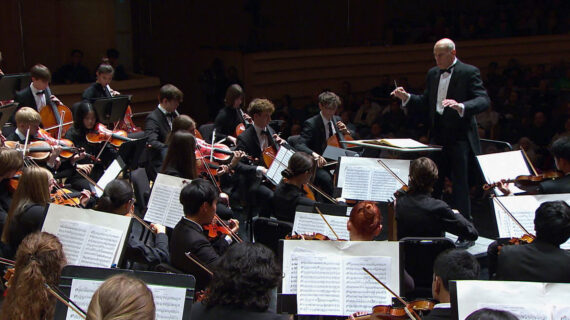Frederica Freyberg:
In this week’s look ahead the United States Supreme Court will rule on a Wisconsin case that could have major ramifications across the national political spectrum. The case is Gill versus Whitford and centers on a dispute over whether Wisconsin's Republican-drawn legislative boundaries are indeed gerrymandering. Challengers say these district maps unconstitutionally benefit Republicans. The lower courts have already ruled these maps unconstitutional. Election law experts say the Wisconsin case is the best chance yet for the high court to put limits on what lawmakers may do to gain a partisan advantage in creating political district maps. Wisconsin Assembly Minority Leader Peter Barca of Kenosha said quote, now that the Supreme Court has decided to hear the case there could be a precedent set to end extreme partisan gerrymandering. Voters should be able to choose their representatives, not the other way around. Wisconsin Attorney General Brad Schimel is charged with defending the Republican-drawn districts and said, quote, I'm thrilled the Supreme Court has granted our request to review the restricting decision. Our redistricting process was entirely lawful and constitutional and the district court should be reversed. So in tonight’s closer look, the Supreme Court's ultimate ruling could shift how legislative and congressional lines are drawn in every state. As a result, who controls state houses and Congress? Wisconsin Public Radio Capitol Bureau Chief Shawn Johnson has been tracking this case through the lower courts for months. Shawn joins us with his perspective and insight. Thanks for being here.
Shawn Johnson:
Hi Fred.
Frederica Freyberg:
How big of a deal in your estimation and in others is this that this case went to the U.S. Supreme Court?
Shawn Johnson:
It's big in Wisconsin because it’s our map. It would change the way that we divide up legislative districts. Potentially change who gets elected in the Wisconsin legislature but it’s much bigger than that. Because it’s a big national deal. It’s saying this redistricting process, which everyone knows has a partisan element to it. It’s saying there is a point at which somebody can get too partisan. And Democrats who brought this case are saying that’s what happened in Wisconsin. And they want the Supreme Court to use this case and what happened here as a template for saying no. That is rejecting other, what they view as partisan gerrymanders around the country.
Frederica Freyberg:
Why did the high court decide to take Wisconsin's case in particular?
Shawn Johnson:
I think bottom line, the three-judge federal panel that struck down Wisconsin's map on a 2-1 decision is what made this case ripe for that appeal. That panel upset the status quo. It changed the status quo. It sided with this partisan gerrymandering case. And said yes, you can strike down a map for being too partisan for discriminating against Democratic voters. In this case because of their political beliefs, making it harder for them to translate votes to legislative seats. Once that court made that ruling it made it very likely the Supreme Court was going to want to get involved.
Frederica Freyberg:
The argument on the part of the challengers to the maps is Republicans drew the lines knowing full well that Democratic votes would be quote wasted. Is this a novel challenge?
Shawn Johnson:
It's a novel way of measuring an old phenomenon. What plaintiffs have done in this case is they have come up with the new metric they call the efficiency gap. It is a way of measuring what has gone on forever in redistricting. The party in charge of drawing the maps, as Republicans were after the 2010 election when they had the legislature and governor’s office. They are able to crack and pack voters from the other side. So pack a bunch of Democratic voters into districts that they’re going to win anyways. So that they’re quote wasting votes. Overvoting in those districts. And then you crack them, spread them out in other districts where they come up just short and end up wasting those votes, too. They put a new metric on that that can measure one state’s maps against another. And by that metric, the efficiency gap, Wisconsin has one of the biggest partisan gerrymanders over the last 40 years.
Frederica Freyberg:
Meanwhile the court stayed or declined the lower court's ruling that Republicans in Wisconsin had to draw up new maps by the 2018 elections. And GOP leaders like Attorney General Schimel have been saying that this is a victory right out of the gate. What do you know about what experts are saying as to whether or not that stay has anything to do with their thinking on the case itself?
Shawn Johnson:
You know it’s definitely positive for Republicans because at least the experts that we’ve talked to say that makes it more likely, no matter what happens in this case, even if the court were to agree and say yes, this was an unconstitutional gerrymander. It makes it more likely that this map will be in place for the 2018 election. So it’s a win for Republicans. As to whether or not it gives you some inclination of where justices are going to rule, possibly. Because one reason they would issue a stay is they think that Republicans are going to eventually prevail. But they could be issuing that stay because they don’t want to upset the status quo while they’re hearing this case. That is they don’t know where they’re going with it.
Frederica Freyberg:
All right. Shawn Johnson. Thanks.
Shawn Johnson:
You’re welcome.
Search Episodes
Related Stories from PBS Wisconsin's Blog

Donate to sign up. Activate and sign in to Passport. It's that easy to help PBS Wisconsin serve your community through media that educates, inspires, and entertains.
Make your membership gift today
Only for new users: Activate Passport using your code or email address
Already a member?
Look up my account
Need some help? Go to FAQ or visit PBS Passport Help
Need help accessing PBS Wisconsin anywhere?

Online Access | Platform & Device Access | Cable or Satellite Access | Over-The-Air Access
Visit Access Guide
Need help accessing PBS Wisconsin anywhere?

Visit Our
Live TV Access Guide
Online AccessPlatform & Device Access
Cable or Satellite Access
Over-The-Air Access
Visit Access Guide
 Passport
Passport








Follow Us